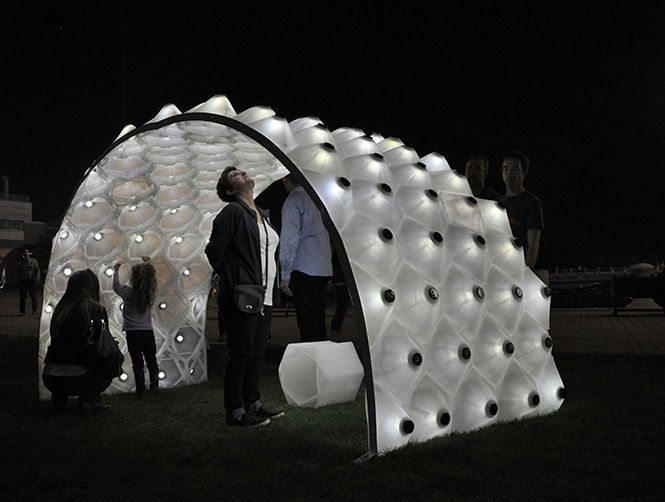A bright idea: KSU professor combines 3-D and solar panel technologies in new project
February 1, 2015
With the advancement of architecture and 3-D printing technology, a Kent State professor created a solar-powered pavilion capable of capturing the sun’s path.
Brian Peters, an assistant professor in the College of Architecture and Environmental Design, spent last summer constructing the Solar Bytes Pavilion in Kent State’s Robotic Fabrication Lab.
The pavilion consists of 94 individual pieces, called bytes, made of a translucent plastic that allows the bytes to glow. The bytes snap together to form the arched pavilion, Peters said.
Each individual byte features a solar panel that records the sun’s light during the day, which is then mimicked and reflected at night by an LED light inside each piece.
“Let’s say, for instance, that it’s sunny in the morning and cloudy in the afternoon; at night the pavilion kind of plays back the sun’s exposure,” Peters said. “So the pavilion would be brighter on the east end and fading out much quicker on the west end.”
Current architecture trends allow Peters and other architects to test ideas and build them at full scale. “Being able to design it and build it at the same time is kind of the driving force,” said Peters.
Hapco Inc., a manufacturing company in Kent, provided Peters with the industrial thermoplastic extruder used for constructing the bytes. The extruder was attached to a robot arm that performed the 3-D printing task, Peters said.
“We were interested in partnering with Brian because of his abilities and what we thought he could have done with our equipment,” said Chuck George, CEO of Hapco Inc. “We were impressed with what he was able to do.”
The Solar Bytes Pavilion was displayed at Cleveland’s Ingenuity Festival in September.
“Ingenuity Festival is a celebration of creativity and innovation, so we like to showcase projects that show things in a different way than people are used to seeing them,” said Paula Grooms, executive director of Ingenuity Festival. “I think the people who saw the pavilion at night were really intrigued with how it was glowing and where the power was coming from.”
The pavilion was created to emphasize the energy changes occurring in technology and architecture. “It’s supposed to forecast a potential future,” said Peters. “Some of these ideas are available, but it’s not really being used to its full potential.”
The pavilion was recently featured in an article in Architect Magazine. Peters was also awarded the publications 2014 R+D Award for Building Bytes, which is a 3-D printing idea used in architecture. Peters used the same concept in the construction of the Solar Bytes Pavilion.
Peters said he also teaches similar elective classes focused around his area of research. One of his classes designed, fabricated and installed a wall at Blackstone LaunchPad in the Kent Student Center last semester.
“3-D printing allows people to do so many more complex forms than before,” Peters said. “The pavilion highlights a potential for architecture and exciting new opportunities using new technology for 3-D printing.”
Contact Julianne Calapa at [email protected].

























